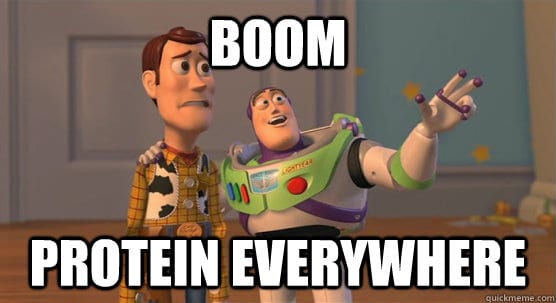This post is over three years old, the information may be outdated.
For the last instalment of my #meatlessmondays series here at Charlie, we’re looking into how you can meet your protein needs with a vegetarian diet. It’s one of the most common questions a vego needs to field, sometimes from relative strangers whose interest in your protein intake is a little odd. It’s not as difficult as you might think to meet, and even exceed your daily protein requirements with plant-based sources of protein- and if you’re a lacto-ovo vegetarian, it’s a breeze.
What do I need protein for, anyway?
An essential nutrient, protein consists of amino acids that perform vital functions in our bodies- from maintaining our metabolism and providing energy, to building connective tissue and developing muscle. While our bodies can produce some of the 20 amino acids found in protein, there are nine essential amino acids that we can only receive through diet. So consuming protein in the right amount for your body weight and physical needs is vital to many functions in the body.
How much is enough?
The amount of protein you need to consume on a daily basis depends on your age, sex and weight. If you are pregnant or lactating, you will also have increased protein requirements. Check out this handy guide to calculate both your estimated average requirement and recommended dietary intake. I, for instance, need to consume 49-60 grams of protein per day, and my three year old daughter needs 12-14 grams.
What high protein foods can I rely on?
As we are lacto-ovo vegetarians, meeting my protein RDI isn’t a struggle- a couple of eggs, a wholemeal sandwich with cheese, a handful of nuts and a small yoghurt keeps me out of trouble. If you’re steering clear of all animal products, never fear- there are plenty of plant-based foods high in protein. If you’re a soy fan (see last week’s deconstruction of soy to help inform your opinion), a glass of soy milk or 120g of tofu/soy meat will give you a whopping 10 grams of protein. Two cups of cooked pasta, a can of baked beans, or 60 grams of nuts and seeds will also provide you with around 10 grams of protein a pop. Beans, lentils and chickpeas are seriously packed with protein goodness, weighing in with at least 12 grams of protein per cooked cup. Quinoa is another heavy contender for my favourite protein source, with a decent 11 grams of protein per cup. Don’t forget your dark green veggies either- spinach and broccoli are filling, nutritious and packed with protein, with broccoli giving you a bonus 5 grams of protein per cup.
See? It’s not as hard as you may have thought to meet your protein requirements on a meatless diet. As a bonus, vegetarian protein sources don’t include excess fat, and you’re less likely to overdo it on protein, which can place strain on your kidneys and lead to poor digestion.
Thanks for joining me on the #meatlessmonday ride- I hope we have all learned a thing or two, and improved both our diets and footprint along the way! With 2016 nearly upon us, why not commit to a year of meatless Mondays?










